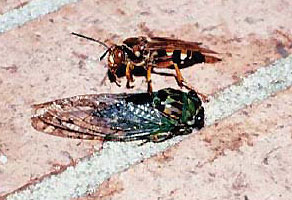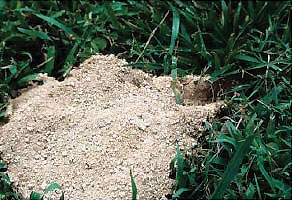Cicada Killer Wasp
In mid- to late summer people begin to encounter large wasps with distinctive bands of white and yellow on black bodies. The head and thorax are a rusty red and the wings are tinged with yellow. The body is about 1.25 to 1.5 inches long. The wing span approaches three inches. Their large size and habit of buzzing around a person terrifies many people.
The female wasps are equipped with a stinger and if seriously provoked can produce a painful sting. The females are territorial and will investigate any thing or anyone coming near their nest burrow. If a person stands still, the female will usually go on about her business.

A cicada killer wasp with an annual cicada
When cicada killers first emerge, the males are very territorial and will fight with each other while establishing territories. Once females begin to emerge the males will attempt to capture them and mate. The males will make every attempt to defend their territory against any invader, including people. The males do not have a stinger and are harmless. However, they can terrify anyone who is afraid of bees and wasps.
Cicada killers are solitary wasps. This means that each female has her own burrow. The burrows are dug in well drained sites. They prefer sandy or bare soils, but will also construct burrows in areas where the grass is kept very short. They can be a real problem in playgrounds and parks where sand has been installed for sports or around playground equipment. They are also a problem around sand traps, tees, and greens on golf courses.
Cicada killers hunt annual or dogday cicadas in trees. When a cicada is spotted, the wasp zooms in and attempts to sting the cicada. The sting paralyzes the cicada. The cicada will utter a buzzing shriek until it becomes paralyzed. Once the cicada becomes motionless, the wasp will carry the cicada to a high point and attempt to fly back to her burrow. While larger wasps may be successful on the first attempt, smaller wasps may need to repeat the process several times.

A cicada killer burrow in a lawn.
At the burrow, the wasp places the cicada in a side chamber and lays an egg on it. The egg hatches, and the wasp larva feeds on the body fluids of the paralyzed cicada. Development is completed within two weeks and the wasp larva forms a cocoon. The winter is spent in the larval stage and pupates the following spring. Adult emergence coincides with the emergence of annual cicadas.
In most cases, control of this wasp is not needed. When the burrows are in an area where there is a high risk of someone getting stung, control may be needed. The best approach is to treat the individual burrows with an insecticide formulated as a dust. As the wasp enters or leaves the hole the dust will adhere to her body. As she attempts to clean her body, some of the insecticide will be picked up and it will kill the wasp.
Prepared by Clyde S. Gorsuch, Extension Entomologist/ Professor, Department of Entomology, Soils, and Plant Sciences, Clemson University
Providing Leadership in Environmental Entomology
Department of Entomology, Soils, and Plant Sciences, 114 Long Hall, Clemson, SC, 29634-0315, 864-656-3111
This information is supplied with the understanding that no discrimination is intended and no endorsement by the Clemson University Cooperative Extension Service is implied. Brand names of pesticides are given as a convenience and are neither an endorsement nor guarantee of the product nor a suggestion that similar products are not effective. Use pesticides only according to the directions on the label. Follow all directions, precautions and restrictions that are listed. EIIS/TO-15 (New 08/2003).
